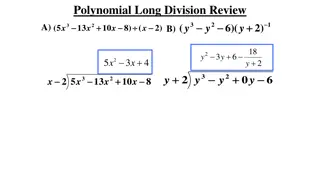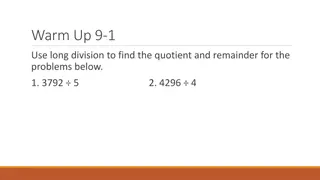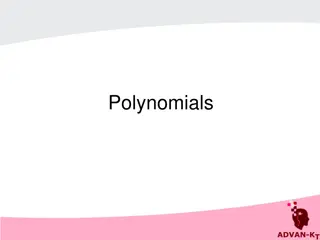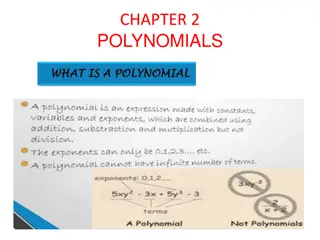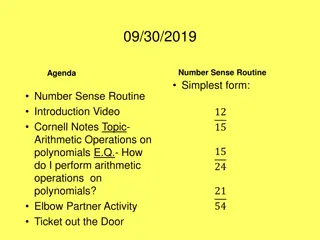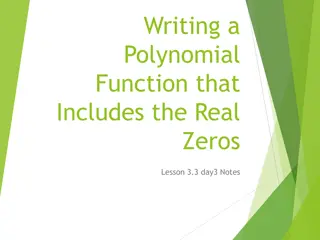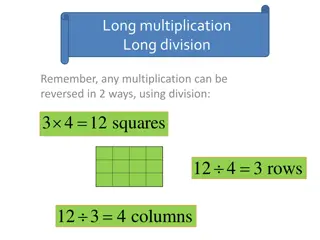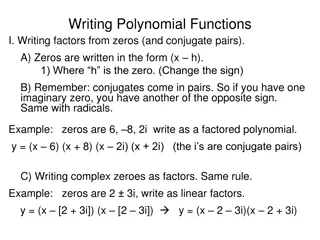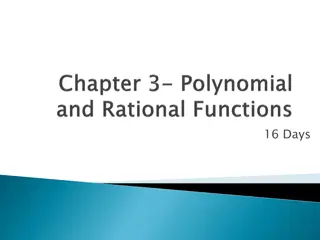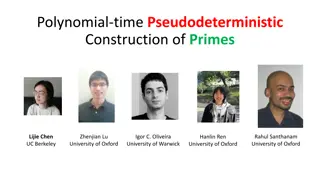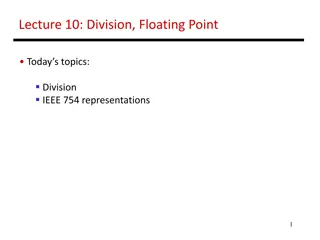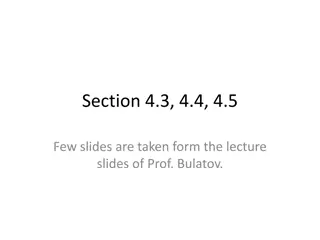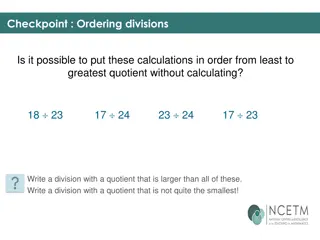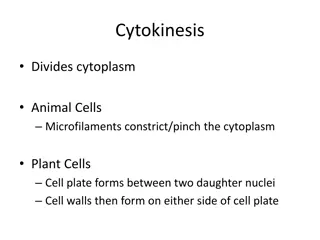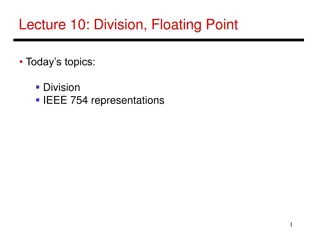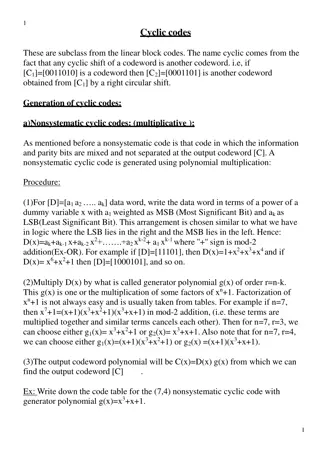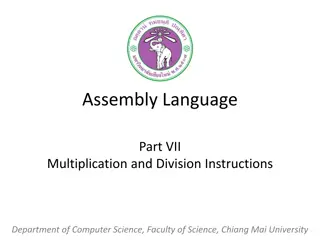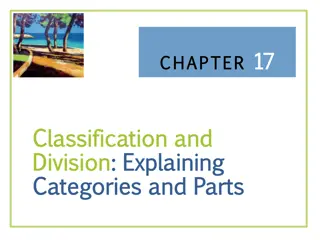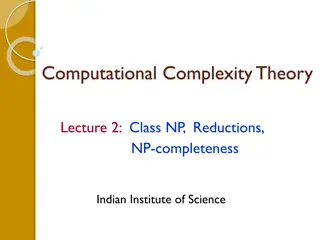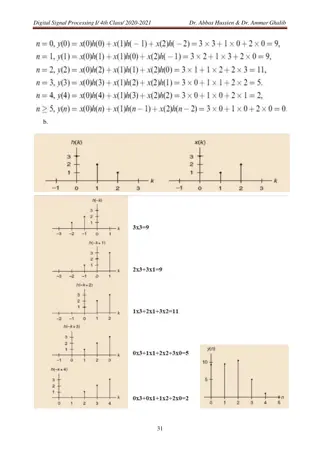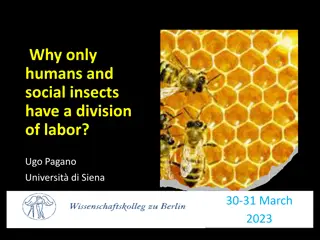Polynomial Division Methods and Examples
Dividing polynomials involves using methods like long division or equating coefficients. By applying these techniques, you can determine whether a polynomial divides exactly or leaves a remainder. The process is similar to long division of numbers, where the dividend is divided by the divisor to obtain a quotient and a possible remainder. Through examples and explanations, you can learn how to divide one polynomial by another using long division, finding the quotient and remainder. Understanding these principles is essential for polynomial manipulation in mathematics.
Download Presentation

Please find below an Image/Link to download the presentation.
The content on the website is provided AS IS for your information and personal use only. It may not be sold, licensed, or shared on other websites without obtaining consent from the author. Download presentation by click this link. If you encounter any issues during the download, it is possible that the publisher has removed the file from their server.
E N D
Presentation Transcript
14 September 2024 Division of polynomials LO: Use long division or equating coefficients to divide polynomials. www.mathssupport.org
Dividing polynomials Suppose we want to divide one polynomial f(x) by another polynomial of lower order g(x). There are two possibilities. Either: g(x) will leave a remainder when divided into f(x). g(x) will divide exactly into f(x). In this case, g(x) is a factor of f(x) and the remainder is 0. We can use either of two methods to divide one polynomial by another. These are by: using long division, or writing an identity and equating coefficients. www.mathssupport.org
Dividing polynomials by long division Using long division The method of long division used for numbers can be applied to the division of polynomial functions. Let s start by looking at the method for numbers. For example, we can divide 5482 by 15 as follows: 3 6 5 This tells us that 15 divides into 5482 365 times, leaving a remainder of 7. We can write 5482 15 = 365 remainder 7 15 5 4 8 2 4 5 9 8 9 0 or 5482 = 15 365 + 7 8 2 7 5 The dividend The divisor The quotient The 7 = + remainder www.mathssupport.org
Dividing polynomials by long division We can use the same method to divide polynomials. For example: Let f(x) = 2x3 3x2 + 1 and g(x) = x 2, divide f by g This tells us that 2x3 3x2 + 1 divided by x 2 is 2x2 + x + 2 remainder 5. There is a remainder and so x 2 is not a factor of f(x). We can write 2x3 3x2 + 1 x 2 2x2 + x + 2 x 2 2x3 3x2 + 0x+ 1 2x3 4x2 x2+ 0x x2 2x ( ) ( ) 5 2x + 1 2x 4 = (2x2 + x + 2) + x 2 ( ) or (x 2)(2x2 + x + 2) = + 2x3 3x2 + 1 5 5 The divisor The quotient The The dividend = + remainder www.mathssupport.org
Dividing polynomials by long division We can use the same method to divide polynomials. For example: Let f(x) = 2x3 3x2 + 1 and g(x) = x 2, divide f by g 2x3 3x2 + 1 (x 2)(2x2 + x + 2) = + 5 2x2 + x + 2 x 2 2x3 3x2 + 0x+ 1 2x3 4x2 x2+ 0x x2 2x ( ) The divisor The quotient The The dividend ( ) = + remainder Theorem: For any two polynomials f and g there are unique polynomials q and r such that f(x) = g(x) q(x) + r(x) for all real values of x. 2x + 1 2x 4 ( ) 5 The polynomial q is called the quotient and the polynomial r is called the remainder. The degree of the polynomial r is smaller than the degree of the polynomial g. www.mathssupport.org
Dividing polynomials by long division Here is another example: What is f(x) = x3 x2 7x + 3 divided by x 3? This tells us that x3 x2 7x + 3 divided by x 3 is x2 + 2x 1. + 2x 1 x2 x 3 x3 x2 7x + 3 x3 3x2 2x2 7x 2x2 6x ( ) ( ) The remainder is 0 and so x 3 is a factor of f(x). We can write x + 3 x + 3 ( ) 3 2 7 +3= 3 or x x x 2 +2 1 x x x 0 x3 x2 7x + 3 =(x 3)(x2 + 2x 1) www.mathssupport.org
Dividing polynomials by equating coefficients Using the method of equating coefficients Polynomials can also be divided by constructing an appropriate identity and equating the coefficients, based in this theorem: For any two polynomials f and g there are unique polynomials q and r such that f(x) = g(x) q(x) + r(x), for all real values of x. The polynomial q is called the quotient and the polynomial r is called the remainder (divisor)(quotient) (remainder) dividend = + The degree of the polynomial r is smaller than the degree of the polynomial g. www.mathssupport.org
Dividing polynomials by equating coefficients For example: What is f(x) = 3x2 + 11x 8 divided by x + 5? We can write f(x) = 3x2 + 11x 8 in terms of a quotient and a remainder as follows: 3x2 + 11x 8 = (x + 5)(quotient) + (remainder) To obtain a quadratic polynomial the quotient must be a linear polynomial of the form ax + b. We can write the following identity: 3x2 + 11x 8 (x + 5)(ax + b) + r Expanding: 3x2 + 11x 8 ax2+ bx + 5ax + 5b + r ax2 + (b + 5a)x + 5b + r www.mathssupport.org
Dividing polynomials by equating coefficients 3x2 + 11x 8 ax2 + (b + 5a)x + 5b + r Equating the coefficients of x2: a = 3 Equating the coefficients of x: But a = 3 so b + 5a = 11 b + 15= 11 b = 4 5b + r = 8 20 + r = 8 Equating the constants: But b = 4 so r = 12 3x2 + 11x 8 (x + 5)(ax + b) + r We can use these values to write 3x2 + 11x 8 (x + 5)(3x 4) + 12 So 3x2 + 11x 8 divided by x + 5 is 3x 4 remainder 12. www.mathssupport.org
Thank you for using resources from A close up of a cage Description automatically generated For more resources visit our website https://www.mathssupport.org If you have a special request, drop us an email info@mathssupport.org www.mathssupport.org


